No study has shown that antidepressants known as selective serotonin reuptake inhibitors — SSRIs — cause people to be violent.
But for years, Health and Human Services Secretary Robert F. Kennedy Jr. has floated antidepressants as a potential cause of violence, including mass shootings.
The U.S. Centers for Disease Control and Prevention “is finally confronting the long-taboo question of whether SSRIs and other psychoactive drugs contribute to mass violence,” Kennedy said in a Nov. 4 X post.
Health officials have long monitored the side effects of such drugs, which millions of people use. Although future research could uncover new findings, existing data points don’t reflect that SSRIs cause mass violence. Here’s what we do know.
#1: Nearly 29 million U.S. adults took antidepressants for depression in 2023.
SSRIs treat mental health conditions such as depression, anxiety, post-traumatic stress disorder and obsessive-compulsive disorder. Brand name drugs such as Prozac, Zoloft, Celexa and Lexapro are all SSRIs.
Depression is common, and many people use SSRIs.
In 2023, the most recent year for which there’s CDC data, about 11% of U.S. adults took prescription medication for depression. The U.S. Census Bureau estimated about 262.3 million adults lived in the U.S. that year. That means that in 2023, about 28.85 million adults took prescription medication for depression. That number doesn’t include minors who took such medications, or adults who took antidepressants to treat conditions other than depression.
#2: Mass violence is rare.
In the same way there’s no single definition of a mass shooting, there is no one definition of mass violence.
Experts who study it, however, say mass shootings are rare. They’re also what Dr. James Knoll, director of forensic psychiatry at SUNY Upstate Medical University and Dr. Ronald Pies, a psychiatry professor at Tufts University School of Medicine, described as “disproportionately an American phenomenon.” SSRI use, in contrast, is not unique to the U.S.
#3: Since 1988, SSRI use has increased, but violent crime has not.
Prozac, the first SSRI available in the United States, launched in 1988. Since then, antidepressant use has increased significantly. From 1988 to 2008, the CDC reported a nearly 400% increase in antidepressant use.
Although no one factor can explain national crime trends, an increase in SSRI use has not resulted in more violent crime. Violent crime rates rose from 1988 to 1991, but then began a more consistent downward trend.
In 1988, the violent crime rate per 100,000 people was 640.6. In 2023, it was 363.8.
We haven’t seen a massive increase in violent crime in the United States or Europe since SSRIs were introduced, despite millions of people being prescribed the drugs, said forensic psychiatrist Dr. Gwen Adshead.
#4: The people most likely to take SSRIs aren’t the most likely to perpetrate mass violence.
If using SSRIs made a person more likely to commit acts of mass violence, we’d expect the demographics of SSRI users to better correspond with the demographics of people who commit mass violence.
That’s not the case.
“We have not seen an increase in violent crime by the general population of people with depression and anxiety,” Adshead said. “The demographic of people who kill or commit violent crimes have not changed.”
For example: Data shows men are more likely to perpetrate violence, but women are more likely to be prescribed SSRIs.
“If there was a connection or link, one would expect it to be pronounced, or at least much greater than we are seeing,” Knoll previously told PolitiFact. “Why do we not see increased violence in women? People over 60?”
If SSRIs were linked to mass violence, Dr. Ragy Girgis, a Columbia University clinical psychiatry professor who studies mass violence, said we’d expect people who perpetrate mass violence to be more likely to be treated with SSRIs than the general population.
“The data show that people who perpetrate mass violence are actually less likely to have received treatment with an SSRI,” Girgis said.
An analysis of Columbia University’s Mass Murder Database found that about 4% of mass shooting perpetrators in the past 30 years had used antidepressants in their lifetime — a rate below that of the general population.
#5: Research has not proved SSRIs cause mass violence.
Some studies show an association between SSRI use and violence, but association is not the same as causation.
When Knoll and Pies reviewed existing data, they found no evidence establishing a direct causal connection between antidepressants and violence.
“Most violence, especially fatal violence, involves a complex interaction between two people,” Adshead said. “Drugs, prescribed or otherwise, can affect people’s mental states and are known to increase violence risk.”
Some data shows that SSRIs can increase impulsivity for some people while other data has shown SSRIs help reduce it.
RELATED: RFK Jr. has targeted antidepressants for kids. How do SSRIs work?

